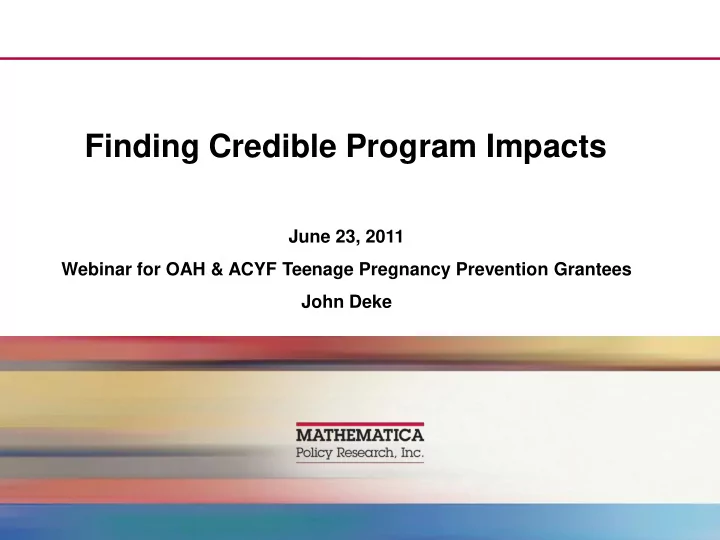

Finding Credible Program Impacts June 23, 2011 Webinar for OAH & ACYF Teenage Pregnancy Prevention Grantees John Deke
Striving for the “Gold Standard” Studies based on can produce highly credible, persuasive evidence of a program’s effectiveness Not automatic – both program implementation and evaluation implementation are keys to success, and both types of implementation rely on program staff Two key objectives: – Program implementation: maintain the contrast between the treatment and control groups – Evaluation implementation: preserve the integrity of random assignment
Maintaining the Contrast 3
Where Impacts Come From An impact is the difference in average outcome between the treatment and control groups A difference in outcomes results from a difference in experiences No difference in experiences, no impact
Impacts Example Sexual Initiation Rates (percentage) 80 70 60 50 40 30 20 10 0 Program 1 Program 2 Program 3 Program Group
Impacts Example: +Control Group Sexual Initiation Rates (percentage) 80 70 60 50 40 30 20 10 0 Program 1 Program 2 Program 3 Program Group Control Group
Maintaining the Contrast Program must be implemented as intended Students in the treatment group must actually participate Students in the control group must NOT participate in the program being studied
Once Randomized, Always Analyzed Students in the treatment group who do not participate (“no - shows”) cannot just be “thrown out” Same for students in the control group who do participate (“cross - overs”)
Preserving the Integrity of Random Assignment 9
Perspective of a Skeptic Important research will be carefully scrutinized Must convince the “ reasonable skeptic ” The burden of proof rests with the evaluator, not the skeptic
Threats to Integrity Assignment becomes purposeful, not random Missing data, for non-random reasons
Assignment Must be Random If assignment to treatment is not random, then we do not know that the treatment and control groups are identical Anything that changes who is in the treatment and control groups could introduce bias HOWEVER – selection for the study does not have to be random
Purposeful Assignment: Example Schools are selected for the study Schools are to treatment and control groups Principals select one section of a health class in each school to participate in the study
Preventing Purposeful Assignment Limit changes in teacher/student assignments after randomization (as feasible) – Conduct random assignment as late as possible Understand special issues before randomization – example, some teachers might be excluded from the study Monitor changes in teaching assignments and student rosters between random assignment and follow-up data collection
Fixing the Example Schools are selected for the study Principals select one section of a health class in each school to participate in the study Schools are to treatment and control groups
Missing Data Bias Equivalence of the treatment and control groups is the key advantage of random assignment This equivalence can be lost if outcome data are not available for all individuals in the study Analogous to purposeful assignment – individuals are selectively removing themselves from the study
Nonrandom Missing Data: Example Random assignment of schools Some schools, teachers, or students dislike the program, stop using/attending Researchers halt data collection – in the schools or classrooms that stopped using the program, OR – for students who stopped using/attending the program
Avoiding Missing Data Once Randomized, Always Analyzed Data needed for all schools, teachers, or students that were randomly assigned Analyze data using original treatment assignment
Fixing the Example Random assignment of schools Some schools, teachers, or students dislike the program, stop using/attending Researchers continue data collection for all schools, classrooms, and students regardless of their program use/attendance Calculate intent-to-treat (ITT) impact
Finding Credible Program Impacts There must be an impact to find – Implement program as intended – High participation rate for the treatment group – Low program exposure for the control group That impact must be credible – Random, not purposeful, assignment/selection – Once randomized, always analyzed
For More Information TPP Eval TA – TPPEvalTA@mathematica-mpr.com – 1-866-336-3880 21
Recommend
More recommend